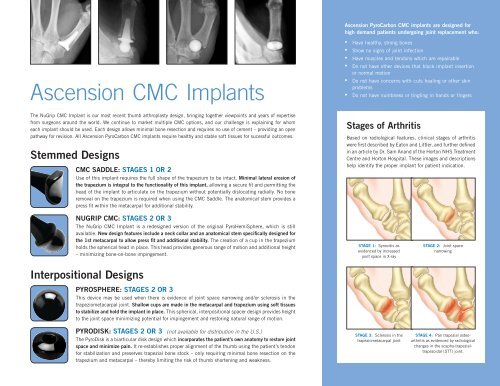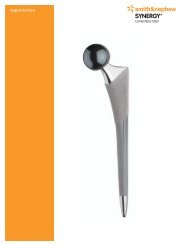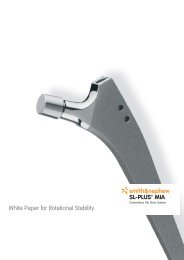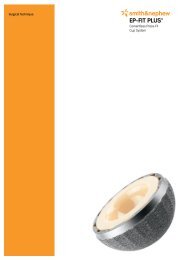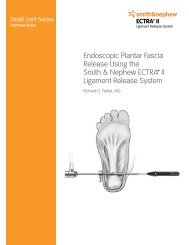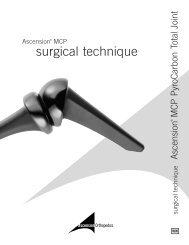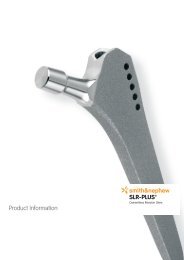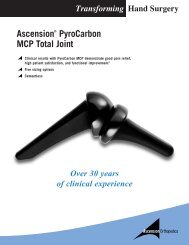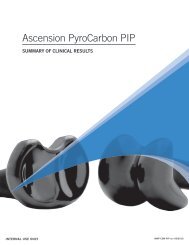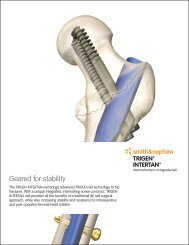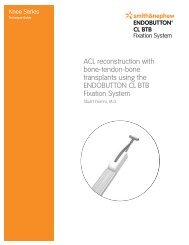PyroCarbon CMC Implants
PyroCarbon CMC Implants
PyroCarbon CMC Implants
Create successful ePaper yourself
Turn your PDF publications into a flip-book with our unique Google optimized e-Paper software.
Ascension <strong>PyroCarbon</strong> <strong>CMC</strong> implants are designed for<br />
high demand patients undergoing joint replacement who:<br />
• Have healthy, strong bones<br />
• Show no signs of joint infection<br />
• Have muscles and tendons which are repairable<br />
Ascension <strong>CMC</strong> <strong>Implants</strong><br />
• Do not have other devices that block implant insertion<br />
or normal motion<br />
• Do not have concerns with cuts healing or other skin<br />
problems<br />
• Do not have numbness or tingling in hands or fingers<br />
The NuGrip <strong>CMC</strong> Implant is our most recent thumb arthroplasty design, bringing together viewpoints and years of expertise<br />
from surgeons around the world. We continue to market multiple <strong>CMC</strong> options, and our challenge is explaining for whom<br />
each implant should be used. Each design allows minimal bone resection and requires no use of cement – providing an open<br />
pathway for revision. All Ascension <strong>PyroCarbon</strong> <strong>CMC</strong> implants require healthy and stable soft tissues for sucessful outcomes.<br />
Stemmed Designs<br />
<strong>CMC</strong> Saddle: STAGES 1 OR 2<br />
Use of this implant requires the full shape of the trapezium to be intact. Minimal lateral erosion of<br />
the trapezium is integral to the functionality of this implant, allowing a secure fit and permitting the<br />
head of the implant to articulate on the trapezium without potentially dislocating radially. No bone<br />
removal on the trapezium is required when using the <strong>CMC</strong> Saddle. The anatomical stem provides a<br />
press fit within the metacarpal for additional stability.<br />
Stages of Arthritis<br />
Based on radiological features, clinical stages of arthritis<br />
were first described by Eaton and Littler, and further defined<br />
in an article by Dr. Sam Anand of the Horton NHS Treatment<br />
Centre and Horton Hospital. These images and descriptions<br />
help identify the proper implant for patient indication.<br />
NUGRIP <strong>CMC</strong>: STAGES 2 OR 3<br />
The NuGrip <strong>CMC</strong> Implant is a redesigned version of the original PyroHemiSphere, which is still<br />
available. New design features include a neck collar and an anatomical stem specifically designed for<br />
the 1st metacarpal to allow press fit and additional stability. The creation of a cup in the trapezium<br />
holds the spherical head in place. This head provides generous range of motion and additional height<br />
– minimizing bone-on-bone impingement.<br />
Interpositional Designs<br />
PYROSPHERE: STAGES 2 OR 3<br />
This device may be used when there is evidence of joint space narrowing and/or sclerosis in the<br />
trapeziometacarpal joint. Shallow cups are made in the metacarpal and trapezium using soft tissues<br />
to stabilize and hold the implant in place. This spherical, interpositional spacer design provides height<br />
to the joint space minimizing potential for impingement and restoring natural range of motion.<br />
PYRODISK: STAGES 2 OR 3 (not available for distribution in the U.S.)<br />
The PyroDisk is a biarticular disk design which incorporates the patient’s own anatomy to restore joint<br />
space and minimize pain. It re-establishes proper alignment of the thumb using the patient’s tendon<br />
for stabilization and preserves trapezial bone stock – only requiring minimal bone resection on the<br />
trapezium and metacarpal – thereby limiting the risk of thumb shortening and weakness.<br />
Stage 1: Synovitis as<br />
evidenced by increased<br />
joint space in X-ray<br />
Stage 3: Sclerosis in the<br />
trapeziometacarpal joint<br />
Stage 2: Joint space<br />
narrowing<br />
Stage 4: Pan trapezial osteoarthritis<br />
as evidenced by radiological<br />
changes in the scapho-trapezialtrapezoidal<br />
(STT) joint.


